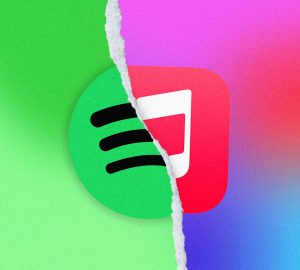
Yo CDs, I’m really happy for you, I’m going to let you finish, but in 2014 streaming music had its best year of all time.
According to a report released last month by the Recording Industry Association of America (RIAA), streaming services out-earned physical CDs last year for the first time in the history of the music industry. Streaming revenues grew to $1.87 billion, while CD revenues fell to $1.85 billion.
Despite streaming music’s relatively narrow margin of victory — a mere $20 million — the writing is on the wall. CDs, barring a miraculous, vinyl-style comeback, are on their way out. The future of music is now, and it’s streaming.
Streaming music’s ascendance seems to suggest a fundamental shift in the way today’s listeners view their tunes — not as commodities to be owned, but as artworks to be appreciated. This development also indicates that today’s listeners are willing to pay (a reasonable price) for their music. The LimeWire generation has grown up.
So now that streaming music has stepped up and pay-to-own services like iTunes’ sales are dwindling accordingly, who are the new gatekeepers of music? Who do I have to throw my wallet at to get my hands on the new Alabama Shakes album?
Spotify is a clear frontrunner in the streaming service showdown. In January the service announced that it had reached more than 15 million paying subscribers, with 60 million active users overall. Spotify’s free version allows on-demand listening that includes ads, while the premium version, at $10 per month, gives users unlimited ad-free, on-demand music, as well as the option to listen offline.
Spotify is hardly running unopposed. Rdio, a similar streaming service founded by one of Skype’s co-creators, has partnered with Google but earned a reputation as “the weird, mysterious kid in the corner” of the struggle for streaming dominance. Deezer, a service founded in France and soon headed stateside, claims to have “the world’s largest online music collection: over 35 million tracks,” topping Spotify’s library of 30 million or so songs. And Rhapsody, a Seattle-based service that recently hit 2.5 million paying subscribers, has been hanging around for over a decade since its founding in 2001.
However, one Spotify competitor in particular has made big waves lately: Tidal, the latest venture from ubiquitous hip-hop artist and businessman — or “business, man,” if you ask him — Jay Z. Tidal is an artist-owned, high-fidelity streaming service born of Aspiro, a Swedish tech company that Jay Z acquired last month. It launched with a star-studded yet bizarre webcast press conference in which a music industry all-star team — a group of artists, including Beyoncé, Daft Punk, Madonna, Kanye West and Rihanna, who are collectively worth over $2 billion dollars — signed a declaration, invoked Nietzsche, and claimed to be ushering in “the future of music.”
Setting all this over-the-top pageantry aside, Tidal is being sold as a way to right the cardinal wrong of the streaming music model, a royalty system that earns very little for its artists. Spotify in particular has taken heat for its meager pay rate, which, according to the Washington Post, earns musicians “seven-tenths of a penny each time a song is played.”
But many are skeptical of Jay Z and company’s faux-noble approach, especially in light of the service’s price tag: to access Tidal’s lossless audio library, subscribers — of which there are currently just 17,000 — must fork over $20 per month. A new tier, offering standard sound quality for $10 per month, was introduced about two weeks ago, presumably in response to the uproar over Tidal’s prices. The service offers no free option.
Whether Tidal takes off or not, it’s clear that we are now living in a brave new musical world. In an interview with The Daily Beast, members of Mumford and Sons criticized Tidal. Vocalist Marcus Mumford noted, “When they say it’s artist-owned, it’s owned by those rich, wealthy artists.” But it was guitarist Winston Marshall who cut to the core of music’s new normal: “Music is changing. … This is how people are going to listen to music now — streaming.”























